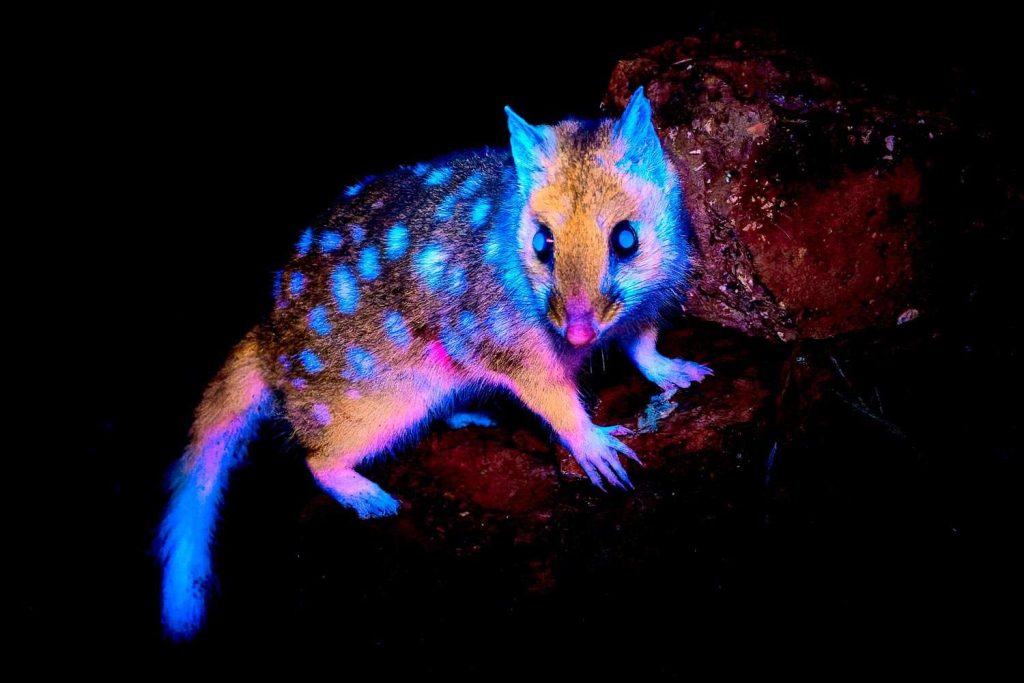:max_bytes(150000):strip_icc():format(jpeg)/Eastern-Quoll-071725-fbf6a31a789443f69595fcf34ba3bb13.jpg)
NEED TO KNOW
- A photographer in Australia has become the first person to capture footage of a glowing marsupial in the wild
- Photographer Ben Alldridge shot a photo of an Eastern quoll, a carnivorous marsupial native to Tasmania, biofluorescing in the dark
- The glow-in-the-dark phenomenon occurs when mammals’ fur is exposed to specific wavelengths of light, like “nature’s version of a white shirt glowing at a disco,” the photographer said
A photographer in Australia has become the first person to capture a photo of a glowing marsupial in the wild.
As part of the 2025 Beaker Street Science Photography Prize, photographer Ben Alldridge submitted a photo of a wild Eastern quoll, a carnivorous marsupial native to Tasmania, exhibiting biofluorescence.
Using invisible ultraviolet light, Alldridge was able to capture the mammal glowing in the dark, and his photo is considered the first photographic evidence of a quoll exhibiting biofluorescence in its natural habitat.
Ben Alldridge / SWNS
“Where their fur is normally fawn or black, under certain wavelengths of light, they exhibit a process referred to as biofluorescence — like nature’s version of a white shirt glowing at a disco,” Alldridge said, per the Daily Mail.
Smithsonian Magazine reported that a number of mammals around the world, many of them nocturnal, are known to exhibit this phenomenon, including polar bears, moles, zebras, wombats, armadillo and more — as well as non-mammals such as corals, insects, spiders, fish, amphibians, reptiles and birds — although the exact biological purpose of biofluorescence is still unknown.
Alldridge and researchers have several theories as to why this phenomenon occurs, and the photographer hopes that his and others’ ongoing studies into biofluorescence will help solve the mystery surrounding it.
“I’d say it’s likely a messaging or identifying system similar to our fingerprints, but that is wild speculation at best,’ he said, per the Daily Mail. “For now, we will just say they like to party.”
Never miss a story — sign up for PEOPLE’s free daily newsletter to stay up-to-date on the best of what PEOPLE has to offer, from celebrity news to compelling human interest stories.
Getty
According to Beaker Street Science, this is the first documentation of the quoll species glowing in the wild, and Alldridge’s photography will be considered a part of the ongoing research into the impacts of light pollution on these animals.
“The amount of light we waste illuminating space — both physical and now literal — is ridiculous, and in many cases is counterproductive to why the lights are installed to begin with,” Alldridge added.
The National Wildlife Federation has reported that light pollution can harm animals’ habitats by causing them to avoid well-lit areas, leading mothers of light-sensitive species to abandon their babies if their habitats become well-lit.
“As we get to grips more with the nocturnal world and how these adaptations work, we can start to optimize our own built environments to introduce as little impact as possible,” Alldridge said.
Alldridge’s photo is one of 12 finalist images that will be exhibited at the Tasmanian Museum and Art Gallery from August 6 to 31 as part of the Beaker Street Festival. Visitors to the exhibition will be asked to vote for their favorite image, and the winners in all categories will be announced at the end of the gallery show.
The PEOPLE App is now available in the Apple App Store! Download it now for the most binge-worthy celeb content, exclusive video clips, astrology updates and more!

